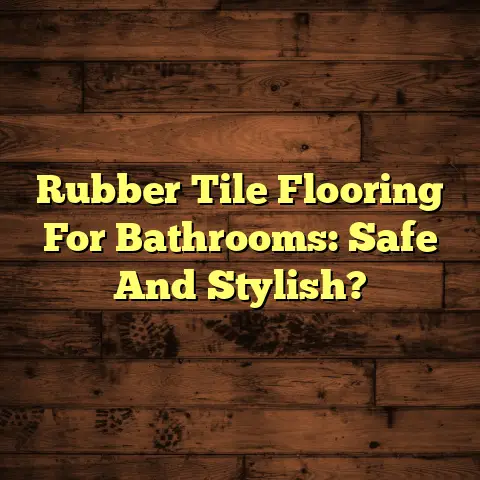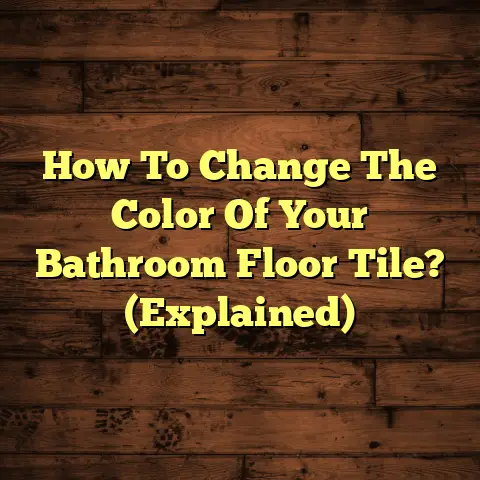Peel & Stick Over Laminate? (Avoid These 3 Fails!)
Imagine you’ve just moved into a beautiful new home, and the first thing that catches your eye is the outdated laminate flooring.
While it has served its purpose, it doesn’t match your personal style, and you’re eager to breathe new life into your space.
You’re tempted by the idea of a quick and
easy flooring solution—peel and stick vinyl
tiles.
They promise simplicity, affordability,
and a fresh aesthetic.
But then, the thought strikes you: what if
this seemingly simple fix turns into a
disaster?
What if the tiles don’t adhere
properly, or worse, what if the underlying
laminate flooring becomes damaged in the process?
I’ve seen it happen more times than I can count in my years as a flooring contractor.
In this article, we will explore the ins and outs of peel and stick flooring over laminate surfaces.
We will delve into the common pitfalls that homeowners face when embarking on this DIY project.
Drawing from real-life experiences and expert
insights, we’ll highlight the three major fails
to avoid, ensuring your flooring makeover is
not only stylish but also long-lasting.
Let’s
dive in, shall we?
Section 1: Understanding Peel & Stick Flooring
So, what are peel and stick vinyl tiles, exactly?
Well, think of them as the superheroes of the
DIY flooring world.
They’re thin, flexible
tiles with an adhesive backing that allows you
to stick them directly onto your existing floor.
No messy mortar, no complicated tools – just peel off the backing and stick it down.
Definition and Characteristics
Peel and stick vinyl tiles are typically made from PVC (polyvinyl chloride) and come in a variety of styles, colors, and patterns.
You can find them mimicking hardwood, stone, ceramic, and even more abstract designs.
They range in thickness, usually from 1.2mm to
2mm, and are generally sold in squares or
planks.
I’ve noticed the thicker ones tend to
be more durable, but of course, they come with
a higher price tag.
Advantages of Peel & Stick
Why choose peel and stick over traditional
flooring?
The biggest draw is the ease of
installation.
As I mentioned, it’s a DIY dream.
They’re also relatively inexpensive compared to
other flooring options like hardwood or ceramic
tile.
Plus, they’re water-resistant (though not waterproof!), making them suitable for kitchens and bathrooms.
Here’s a quick comparison table:
DIY Appeal
The installation process is straightforward:
clean the surface, peel off the backing, and
stick the tile down.
It’s so simple that even
your teenager could probably do it (though I’d
still recommend supervising!).
This ease of use makes them a popular choice for homeowners looking to update their floors without breaking the bank or hiring a professional.
But don’t let the simplicity fool you – there are definitely some potential pitfalls, which we’ll get into later.
Section 2: The Compatibility Factor
Now, let’s talk about the big question: will peel and stick tiles actually stick to your laminate floor?
The answer isn’t a simple yes or no.
It
depends.
Compatibility is key, and there are
several factors to consider.
Assessing Compatibility
First, you need to understand what kind of
laminate you have.
Is it smooth and glossy, or
textured?
Is it relatively new, or has it seen
better days?
The smoother and cleaner the laminate surface, the better the adhesion will be.
Textured laminate can be trickier because the adhesive might not make full contact.
I’ve found that a good rule of thumb is to
test a small, inconspicuous area first.
Stick
a tile down and see if it stays put after a
few days.
If it peels up easily, you might
need to rethink your strategy.
Types of Laminate Surfaces
Laminate flooring comes in various finishes, including:
- Smooth/Glossy: Best for adhesion, but requires thorough cleaning.
- Textured: Can be problematic; may need additional prep.
- Embossed: Similar to textured, but with deeper grooves.
- Handscraped: Very textured; generally not suitable for peel and stick.
Preparing the Laminate
Proper surface preparation is absolutely crucial. I can’t stress this enough!
The laminate needs to be clean, smooth, and
completely dry.
Any dirt, dust, or grease will
prevent the adhesive from bonding properly.
Here’s a step-by-step guide:
- Clean: Use a mild detergent and water to
thoroughly clean the laminate.
Avoid harsh chemicals that could damage the finish. - Rinse: Make sure to rinse off any residual soap.
- Dry: Let the floor dry completely.
This could take several hours, depending on the humidity. - Smooth: If there are any imperfections or unevenness, you might need to use a floor leveler.
- Prime (Optional): Some people recommend
using a primer designed for vinyl flooring
to improve adhesion.
I’ve had mixed results with this, but it’s worth considering, especially if your laminate is particularly glossy or textured.
Section 3: Fail #1 – Poor Surface Preparation
Okay, let’s get to the first major fail: poor
surface preparation.
This is where most DIYers
go wrong, and it can lead to a whole host of
problems down the road.
Common Mistakes
- Skipping the Cleaning: This is the most
common mistake I see.
People think a quick sweep is enough, but it’s not.
You need to thoroughly clean the laminate to remove any dirt, grease, or wax. - Using the Wrong Cleaners: Harsh chemicals
can damage the laminate finish and prevent
the adhesive from bonding.
Stick to mild detergents. - Not Letting the Floor Dry Completely:
Moisture is the enemy of adhesion.
Make sure the floor is bone dry before you start installing the tiles. - Ignoring Imperfections: Any bumps, dents,
or unevenness in the laminate will show
through the peel and stick tiles.
You need to address these issues before you begin.
Effective Cleaning, Smoothing, and Priming
Let’s break down the proper steps for surface preparation:
- Deep Cleaning: Start by vacuuming the
floor to remove any loose debris.
Then, use a mild detergent and warm water to scrub the laminate.
I recommend using a microfiber mop for this, as it’s gentle and effective. - Rinsing: Rinse the floor with clean water to remove any soap residue.
- Drying: Let the floor dry completely.
Open windows or use a fan to speed up the process. - Smoothing: If there are any
imperfections, use a floor leveler to create
a smooth, even surface.
Follow the manufacturer’s instructions carefully. - Priming (Optional): Apply a thin, even
coat of vinyl flooring primer to the
laminate.
Let it dry completely before installing the tiles.
Case Study: The Greasy Kitchen Floor
I once worked with a homeowner who decided to
install peel and stick tiles in her kitchen.
She was excited to update the space on a budget,
but she skipped the deep cleaning step.
Big mistake.
The kitchen floor had a layer of grease and grime that she didn’t even realize was there.
Within a few weeks, the tiles started to peel up, especially in high-traffic areas.
She ended up having to remove all the tiles,
thoroughly clean the floor, and start over.
It
was a costly and time-consuming lesson.
Section 4: Fail #2 – Incorrect Installation Techniques
Alright, you’ve prepped the surface like a pro.
Now it’s time to actually install those peel
and stick tiles.
But hold on – don’t just start
slapping them down willy-nilly.
There’s a right
way and a wrong way to do this.
Best Practices
- Measuring and Planning: Before you even
peel off the backing, measure your floor and
plan the layout.
This will help you avoid awkward cuts and ensure a professional-looking finish. - Acclimating the Tiles: Let the tiles
acclimate to the room temperature for at
least 24 hours before installation.
This will help them expand or contract properly, preventing issues later on. - Aligning and Pressing: When you stick a
tile down, make sure it’s perfectly aligned
with the adjacent tiles.
Press firmly to ensure good adhesion.
Use a rolling pin or hand roller to apply even pressure. - Cutting: Use a sharp utility knife and a
straight edge to make precise cuts.
Replace the blade frequently to ensure clean cuts.
Common Errors
- Overlapping Seams: This is a big no-no.
Overlapping seams create a raised edge that can be a tripping hazard and will eventually peel up. - Improper Alignment: If the tiles aren’t
aligned properly, the entire floor will look
crooked.
Take your time and double-check each tile before sticking it down. - Not Pressing Firmly: If you don’t press
the tiles down firmly, they won’t adhere
properly.
Use a rolling pin or hand roller to apply even pressure. - Ignoring Expansion Gaps: Just like with
any flooring, you need to leave a small
expansion gap around the perimeter of the
room.
This allows the tiles to expand and contract without buckling.
Installation Insights
I’ve found that starting in the center of the
room and working your way outwards is the best
approach.
This helps ensure that the tiles are
evenly spaced and aligned.
Also, don’t be afraid to use spacers to maintain
consistent gaps between the tiles.
You can buy
these at any hardware store.
Section 5: Fail #3 – Ignoring Environmental Factors
You’ve prepped the surface, installed the tiles
perfectly, and everything looks great.
But
you’re not out of the woods yet.
Environmental
factors can play a significant role in the
long-term performance of peel and stick tiles.
Temperature and Humidity
Temperature and humidity can affect the adhesive
on peel and stick tiles.
Extreme temperatures
can cause the adhesive to soften, leading to
peeling.
High humidity can also weaken the
adhesive.
I recommend maintaining a consistent temperature
and humidity level in the room.
Avoid
installing the tiles in areas that are subject
to extreme temperature fluctuations, such as
near a stove or in a sunroom.
Direct Sunlight and Moisture
Direct sunlight can cause the tiles to fade and
become brittle.
Moisture can seep under the
tiles and weaken the adhesive, leading to
peeling.
To mitigate these risks, use area rugs or
curtains to protect the tiles from direct
sunlight.
Avoid installing the tiles in areas
that are prone to moisture, such as bathrooms
or laundry rooms.
If you do install them in
these areas, make sure to seal the edges with
silicone caulk to prevent water from seeping
underneath.
Mitigation Tips
- Use Area Rugs: Area rugs can protect the tiles from direct sunlight and heavy traffic.
- Control Humidity: Use a dehumidifier in humid areas to maintain a consistent humidity level.
- Seal Edges: Seal the edges of the tiles with silicone caulk to prevent water from seeping underneath.
- Choose the Right Tiles: Some peel and
stick tiles are designed for specific
environments.
Choose tiles that are appropriate for the room you’re installing them in.
Section 6: Real-Life Case Studies
Let’s take a look at some real-life examples of
peel and stick installations gone wrong.
By
analyzing these case studies, we can learn from
others’ mistakes and avoid making the same
errors.
Case Study 1: The Bathroom Disaster
A homeowner decided to install peel and stick
tiles in her bathroom.
She didn’t seal the
edges of the tiles, and water seeped underneath,
causing them to peel up within a few months.
What Went Wrong: Failure to seal the edges allowed moisture to penetrate the adhesive.
How to Avoid It: Always seal the edges of peel and stick tiles in wet areas with silicone caulk.
Case Study 2: The Sunroom Fade
Another homeowner installed peel and stick tiles
in her sunroom.
The tiles faded and became
brittle due to direct sunlight exposure.
What Went Wrong: Direct sunlight caused the tiles to degrade.
How to Avoid It: Use curtains or blinds to block direct sunlight, or choose tiles that are designed for outdoor use.
Case Study 3: The Uneven Floor
A homeowner installed peel and stick tiles over
an uneven laminate floor.
The tiles looked
bumpy and uneven.
What Went Wrong: The uneven floor caused the tiles to look distorted.
How to Avoid It: Use a floor leveler to create a smooth, even surface before installing the tiles.
Section 7: Conclusion
So, there you have it – the three major fails to
avoid when installing peel and stick flooring
over laminate.
Poor surface preparation,
incorrect installation techniques, and ignoring
environmental factors can all lead to disaster.
But don’t let these potential pitfalls scare you
away.
Peel and stick vinyl tiles can be a great
solution for updating your floors on a budget.
Just remember to take your time, do your research, and follow the best practices outlined in this article.
With careful preparation and attention to detail, you can achieve a beautiful and long-lasting flooring makeover.
I encourage you to approach your DIY projects
with confidence, armed with the knowledge you’ve
gained from this article.
Happy flooring!





